This post may contain affiliate links.
One Day in Florence
Spending one day in Florence will be busy but glorious. Florence, the Renaissance gem of Italy, is where you’ll see some of the best art in Europe, some of the most remarkable sights, and cross paths with every other tourist in the world.
No matter.
A few thousand travellers clutching their Rick Steves Florence and Tuscany guidebook shouldn’t get in your way. There are so many great things to do in Florence and it’s a city meant to be shared.
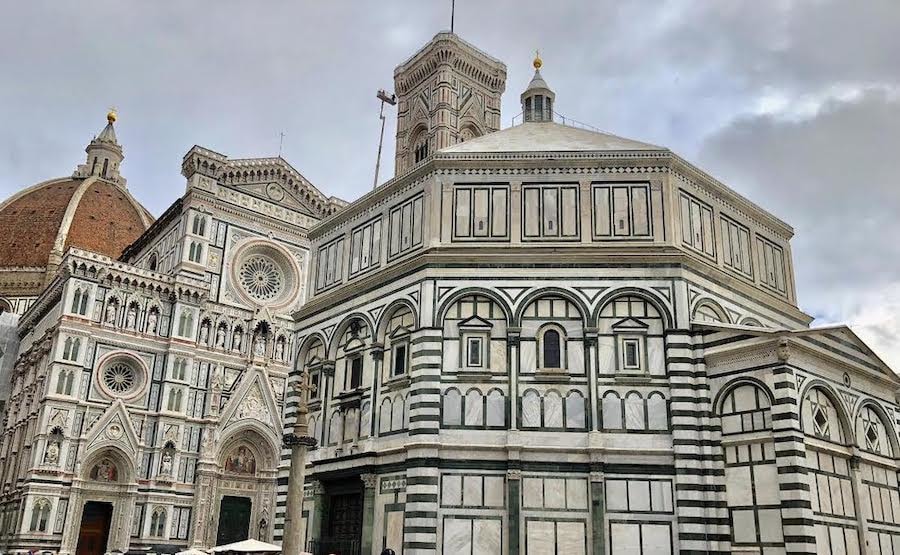
About This Florence in a Day Itinerary
Rich in art, history and Medici intrigue, Florence is a fabulous destination for day-trippers, shoppers and history buffs.
It’s also excellent for ice cream. I recommend the Gelateria dei Neri at Via dei Neri 20-22.
This travel guide will show you the best way to see Florence in a day. We’ll also go into some juicy gossip about the Medicis, the formidable family that ruled Florence during the Renaissance, because a splash of scandalous history makes any trip to Italy more intriguing.
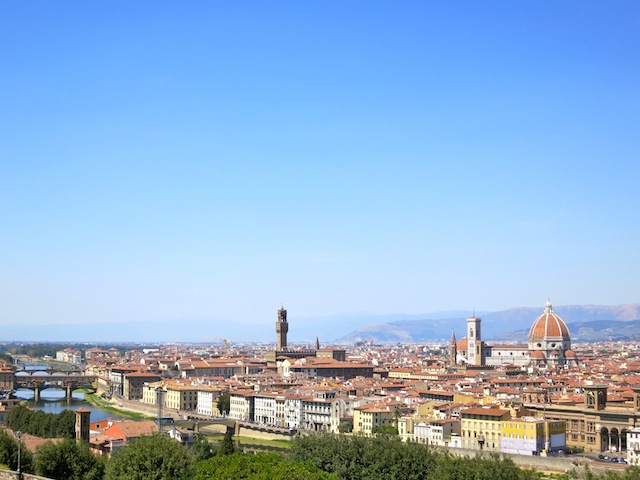
Planning Your Day Trip to Florence
Known as the Cradle of the Renaissance, Florence is the capital of Tuscany and one of Italy’s most popular destinations. For good reason. Together with Venice and Rome, it’s part of an unbeatable trio of Italian cities.
If you’re doing a day trip to Florence you’ll be doing a fair bit of sightseeing – but don’t cram in so much that you don’t have time to stroll around. It’s not called a ‘living museum’ for nothing and you’ll see plenty by meandering through the backstreets.
This 1-day Florence itinerary is jam packed so don’t feel bad if you leave out a tourist attraction or two.
This list of top things to do includes both of the city’s top museums, the Uffizi Gallery and the Accademia (home to the sculpture of David by Michelangelo). You may be tempted to skip one or the other, but my recommendation instead is to do both for a shorter period of time.
Do a quick tour of the Uffizi to see the top sights (especially the two exquisite Botticelli paintings), and squeeze in at least a quick trip to the Accademia as David really is one of those must-see Florence attractions.
Two other top sights you don’t want to miss are the Duomo (the Cathedral of Saint Mary of the Flowers) and the Ponte Vecchio, the covered bridge that crosses the River Arno.
How much time you want to spend shopping, strolling and sipping espressos is up to you. (Well, obviously everything is up to you, I’m just suggesting ….)
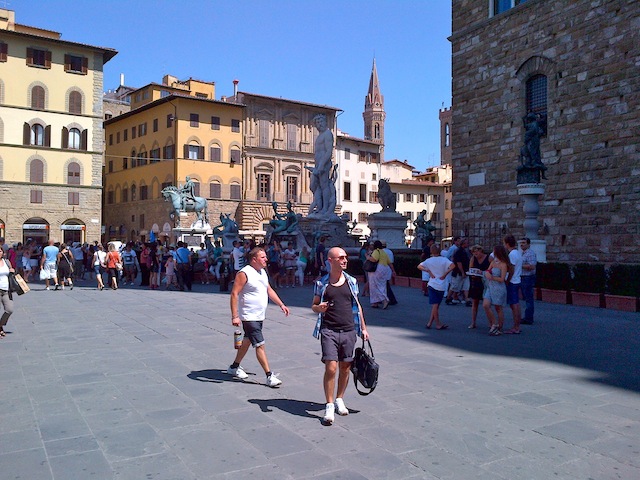
Start at the Uffizi Gallery
Open every day at 8:15 a.m. except Monday (when it’s closed), the Uffizi Gallery is best visited while you’re fresh and the crowds are thinner.
Why visit the Uffizi? By looking at Florence through the eyes of the artists who worked and lived here, you’ll get a rich grounding in Florentine history.
The Uffizi building is a work of art in itself. Built as a headquarters for the Medici family in the 16th century, it was designed by Giorgio Vasari who, if you’re into gossipy art criticism of the 1500s, wrote an excellent book called Lives of the Artists back in the day.
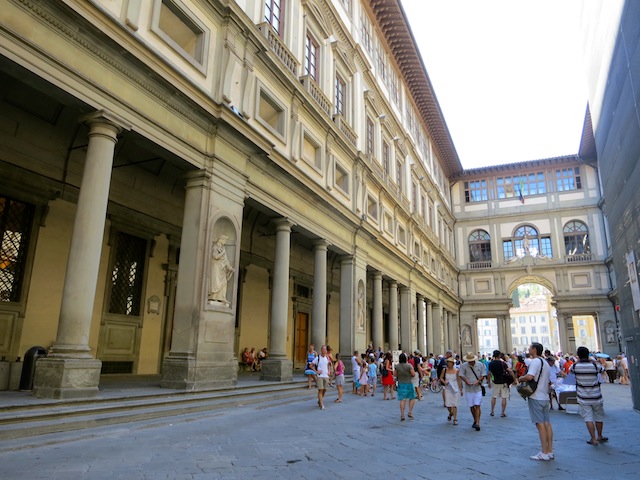
Uffizi Gallery
Uffizi Tickets
If you don’t want to spend the entire day in line, it’s best to buy a Uffizi Gallery ticket with skip-the-line access beforehand. You can sign up for a tour or opt for just an entrance ticket.
My husband Mark and I have done short Uffizi tours twice now and learned so much each time, so it’s our preferred way of visiting. If you’d rather wander around on your own, that’s fun too. I’ll list some must-see masterpieces below.
Book a Uffizi Skip-the-line Timed Entry Ticket here. Or, book a 90-minute Florence Uffizi Gallery Skip-the-line Tour here.
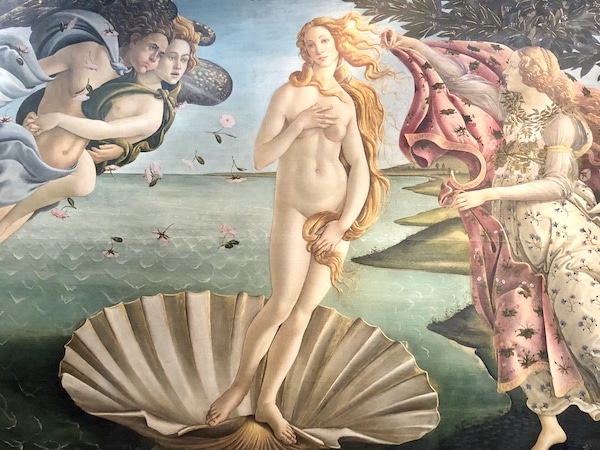
What To See at the Uffizi Gallery
The Birth of Venus and Primavera by Botticelli
Once you’re in the Uffizi Do. Not. Miss. The Birth of Venus, also sometimes called Venus on the Half Shell, painted in 1486, or the lovely Primavera (1482), two masterpieces by the painter Sandro Botticelli.
These are two of the most famous paintings in the Uffizi, and Botticelli, a painter who lived his whole life in Florence, represents the city as no one else can. (Except, my husband insists, for Dante.)
With its pale colours and linear lyricism, Botticelli’s work is almost too romantic to be believed, and during his lifetime he was a hugely successful artist.
But perhaps his art was too pretty. Towards the end of his life ‘pretty’ went out of fashion and was considered too decorative to be serious art.
After the artist’s death, his work fell out of favour and stayed that way until the Pre-Raphaelites of the 19th century rediscovered his work and redeemed the unabashed beauty of his paintings.
Now we can love Botticelli again. Hurrah.
The Birth of Venus, seen on postcards and coffee mugs around the world, depicts the golden-haired goddess of love and beauty. She’s standing on a giant scallop shell as she arrives on the island Cyprus.
It was likely commissioned by one of the Medicis – they were the biggest art patrons of the day.
Strange Botticelli Fact: Botticelli fell under the spell of the populist preacher Savonarola, who has been described as an ugly fleshy man with a big nose who was prone to violence. This fanatical friar roused mobs into a frenzy, burning works of art, prophesying and cleansing Florence of corruption.
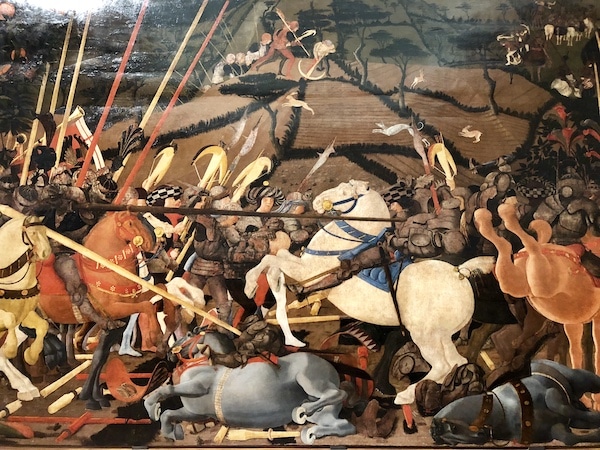
The Battle of San Romeo by Paolo Uccello
Here’s a hidden masterpiece. Art tours through the Uffizi don’t usually stop at the Battle of San Romeo by the late Gothic painter Paolo Uccello, yet it’s one of my favourite paintings of all time.
I was amazed how few people stopped to gaze at this evocative painting celebrating the victory of Florence over their bitter enemy, Siena, back in 1432.
Take a look at Uccello’s mastery over perspective in the battle scene. Not just a painter but a mathematician, he understood perspective and foreshortening like no one else did, and was a key figure in shaping Renaissance art. Need I mention those velvety horses?
Coronation of the Virgin by Fra Angelico
This golden altarpiece was painted by the very pious Renaissance master Fra Angelico – one of the finest painters to come out of Tuscany – around 1432, and shows Jesus crowning the Virgin Mary as the Queen of Heaven.
Portrait of Pope Leo X with Two Cardinals by Raphael
The powerful portrait by Raphael was painted around 1518. While Pope Leo X, the son of Lorenzo de’ Medici, commissioned a number of important artworks for the Uffizi, and therefore we applaud him, he was not known for his piety, but for his debauched and hedonistic lifestyle.
The Annunciation by Leonardo da Vinci
It’s hard to believe this evocative picture of the archangel Gabriel kneeling in front of Mary was painted more than 500 years ago. It’s interesting for its accurate perspective, for the contrast of religious theme and earthy garden setting, and for its incredible beauty.
Head of Medusa by Caravaggio
Caravaggio, the bad boy of the late Renaissance, had a lot to do with ushering in the dramatic style of Baroque art.
His incredible talent got him out of a peck of trouble – the pope couldn’t resist acquiring his art – but eventually a bar fight that ended in him killing a man forced Caravaggio to flee. He ended up dying in exile at the young age of 38.
The subject matter for the Head of Medusa is the figure from Greek Mythology, Medusa, who has snakes for hair and a face that could turn people to stone with a glance. A dark departure from the idyllic scenes of Fra Angelico and da Vinci!
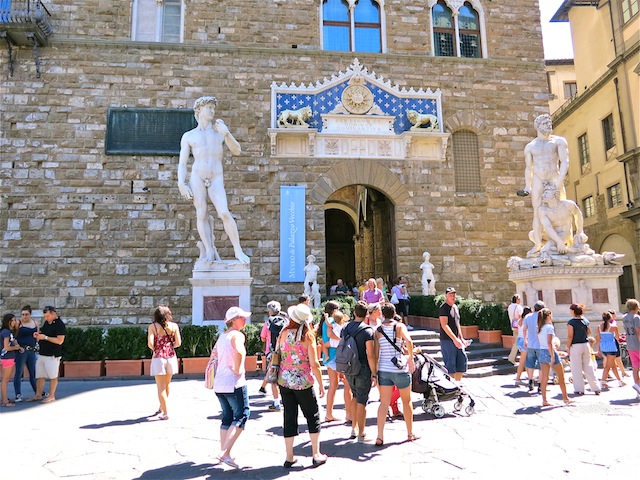
Visit the Piazza della Signoria
Right next to the Uffizi Gallery is the Piazza della Signoria. In this art-laden square you’ll feel as if you’ve found the centre of Florence.
Here you’ll get a special treat – the exciting chance to see the faux statue of David not quite by Michelangelo! As mentioned, the real one is in the Accademia.
To understand the importance of the Piazza della Signoria, you need to step into the past. The piazza has been a pivotal point in Florentine politics and its deadly games of power for hundreds of years.
The Bonfire of the Vanities in the Piazza della Signoria
In 1497, Savonarola, the fanatical preacher that held Florence under his grip, held the infamous Bonfire of the Vanities here, burning thousands upon thousands of ‘frivolous’ objects such as books, mirrors, fine clothing and art – in other words, anything that could distract from the worship of God.
The Burning of the Vanities was the culmination of years of preaching against the ‘paganism’ of the Renaissance.
He’d already ousted the Medicis, who fled the city in 1494 after an angry mob burned down the Medici bank – the family’s financial stronghold.
The Bonfire of the Vanities was the flaming peak of Savonarola’s grasp over the Florentine people. It’s said that even Botticelli himself threw some of his artwork into the fire. (Good thing he didn’t grab The Birth of Venus or Primavera!)
But the tides would turn against Savonarola. In 1498 he was denounced as a heretic and burned at the stake. Where? Right here in the Piazza della Signoria. And in 1530, it’s where the Medicis made their triumphant return.
Learn more with a tour: To dig into the fascinating story of the Medicis you can book a private Florence: Medici Family Experience Tour here.
Check Out the Loggia dei Lanzi
It would be hard to visit the Piazza della Signoria and not notice the open-air sculpture gallery thinly separated from the piazza by huge stone archways. This is the Loggia dei Lanzi, also called the Loggia Signoria, and by various other names.
Under its vaulted roof, the space is filled with sculptures from both the Antiquities and the Renaissance. It’s a stunning sight, but go closer in for a glimpse of the macabre.
First you might notice a bronze statue of Perseus holding up the severed head of the Medusa. Created by Benvenuto Cellini, the sculpture took 10 years to make and has stood here since 1554.
You’ll also find the marble Rape of the Sabine Women by Giambologna, which has been here since 1583. Giambologna’s sculpture of Hercules Beating the Centaur Nessus, which isn’t much more cheery, was installed here much later.
Also on display is the ancient Roman sculpture of Hercules supporting the body of Patroclus, and the 19th-century Rape of Polyxena by Pio Fedi.
It’s a striking collection of sculpture that crosses centuries and styles, and with its overarching theme of violence, clearly symbolizes the city’s (and the Medici family’s) might.
Bonus: Entrance to the Loggia dei Lanzi is free.
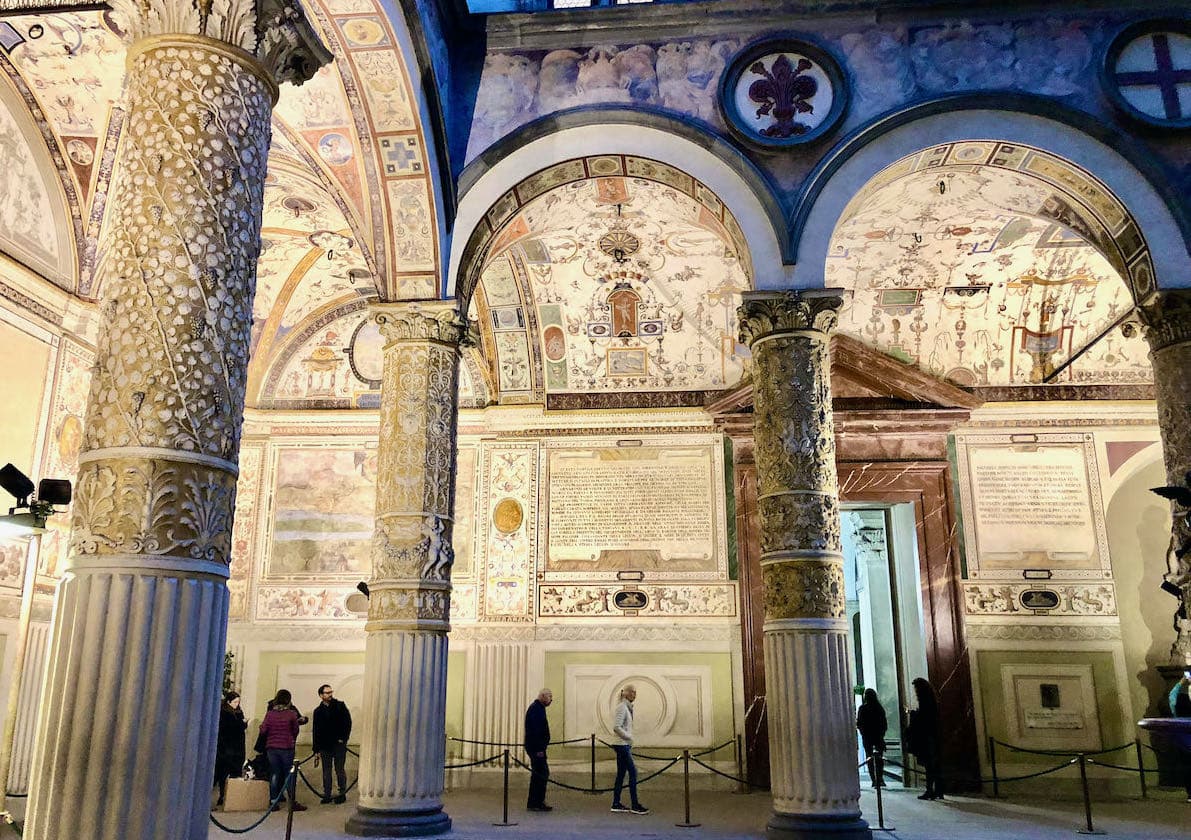
See the Palazzo Vecchio
You can’t see all of Florence in a day, but since you’re at the Piazza della Signoria anyway, take a look at the Palazzo Vecchio, which is directly on the square.
The Palazzo Vecchio is the Old Palace of Florence. Today it’s a museum, clock tower and Romanesque town hall all in one.
As an aside, in Dan Brown’s best-selling thriller Inferno, Langdon and Brooks evade capture by escaping through the Palazzo Vecchio’s secret passageways.
Built between 1299 and 1314, the palace looks a bit grim from the outside but inside it’s more lavish, especially the Hall of the Five Hundred, the Salone dei Cinquecento.
This impressive chamber was added in 1494 – not by the Medicis who, remember, had been run out of the city – but by their mortal foe, Girolamo Savonarola, for whom the hall became a symbol of the new Florentine Republic.
The Hall of the Five Hundred
The biggest room in all of Florence, the Hall of the Five Hundred is 54 meters long, 23 metres wide and 18 metres high. It was designed to hold a council of 500. This way, power over the city would be spread among many, rather than being held by a single family (namely, the Medicis).
It was a short-lived dream. Savonarola had too many enemies. He was denounced, the Medicis came back and reclaimed the Palazzo Vecchio. They put Giorgio Vasari (the designer of the Uffizi) in charge of redoing the Hall of the Five Hundred on a magnificent scale.
The result? Stunning wall frescoes, golden embellishments, elaborate statues and a lavish coffered ceiling.
Fun fact about Inferno and the Hall of Five Hundred. In Dan Brown’s novel, Giorgio Vasari’s ceiling fresco of the Battle of Marciano in the Hall of the Five Hundred holds a clue, the words Cerca Trova. This translates as Seek Find, painted on a tiny triangular green flag.
Climb the Tower at the Piazza Vecchio
Florence has a surprising amount of towers to climb. If you have excess energy feel free to head up the 223 steps of the Palazzo’s clock tower, the Tower of Arnofo.
You can get a Palazzo Vecchio Entrance Ticket with video guide and tower Access here.
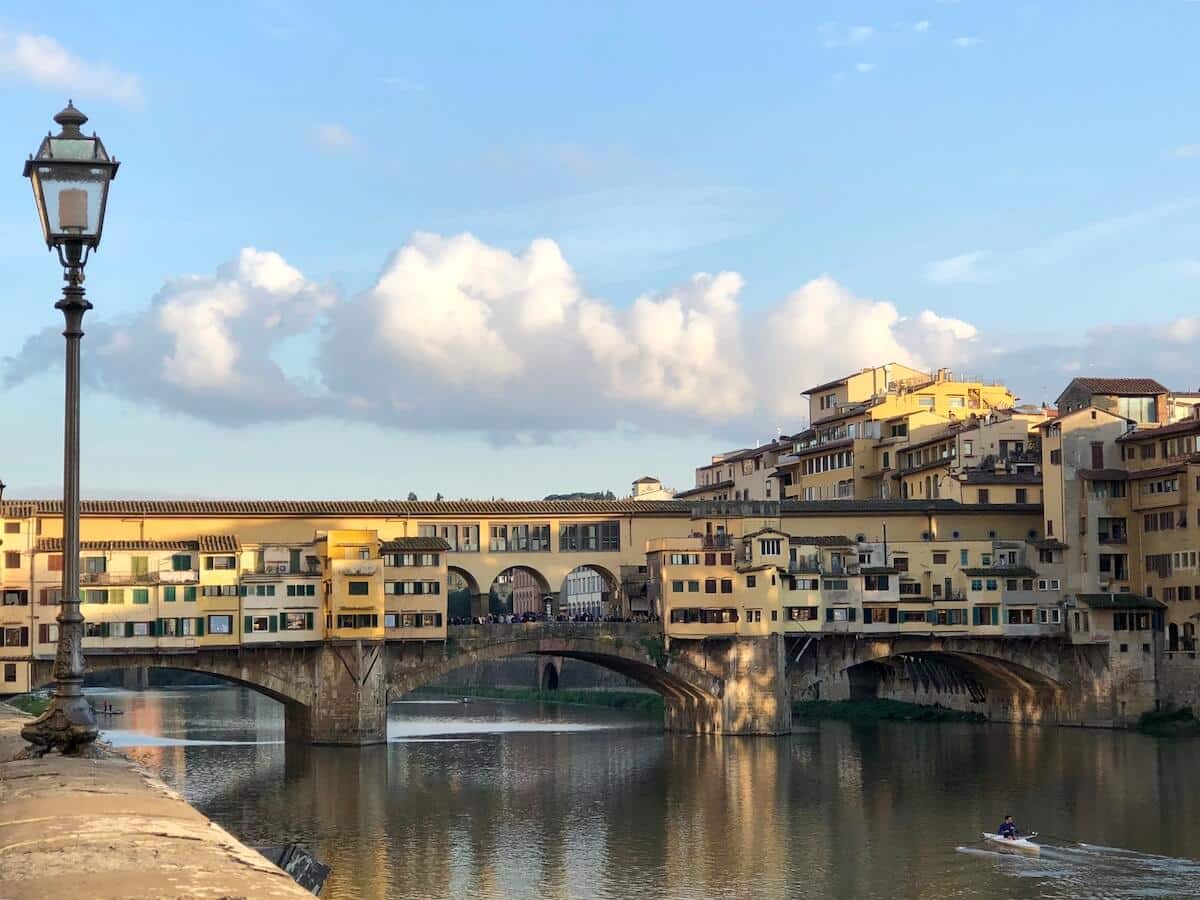
Head to the Ponte Vecchio – the Must-See Florence Bridge
South of the Piazza della Signoria is the River Arno. Here you’ll find the picturesque Ponte Vecchio.
Ponte Vecchio, which means Old Bridge in Italian, is – no surprise – the oldest bridge in Florence. Spanning the River Arno, it’s a photographer’s dream because of the houses built right on it.
Today it’s crammed with gold shops, tourists and entertainers but back in 1345, when it was originally built, it was lined with workshops, butchers, tanners, blacksmiths and the like.
It’s fun if you’re in the mood, a madhouse if you’re not, but either way it’s one of the top things to see in Florence.
Once you’ve muscled your way into a spot by the river to photograph the bridge, it’s time for a lunch break so walk north to the Mercato Centrale.
Eat at the Mercato Centrale
The Mercato Centrale, a historic cast iron and glass building, dates back to 1874. Inside you’ll find the Tuscan delicacies of your dreams, from exquisite olive oils and white truffles to regional salami and ox tongue.
One recommended food stall is Da Nerbone. Feeling adventurous? For some traditional Tuscan cuisine try a lampredotto, slow-cooked stomach of cow. Or maybe just a dish of risotto.
Shop at the Mercato San Lorenzo
One of the most popular Florence activities is to shop. For all your souvenir needs, the Mercato San Lorenzo, next to the Mercato Centrale sells everything from leather bags and jackets to hopelessly tacky keepsakes.
More Shopping in Florence
All in all, much of historic Florence is taken up with leather shops, and north of the Ponte Vecchio you’ll find a gazillion stores. When Mark was shopping for a jacket, we were told that the identical jacket was variously made of goat leather, lamb, baby lamb, or calf, depending on which shop we saw it in.
In many of the small boutiques of Florence you’ll find knockoffs of designer leather fashions and some appealing options, but for the life of me I can’t understand why there seems to be the same 10 jackets in every store.
Mark finally found a shop he liked and bought the jacket, but to this day we can’t remember which animal it’s supposed to have come from. (Update: Now he hates the jacket and never wears it, so be careful what you buy.)
Personally, I prefer The Mall, a designer outlet mall 30 minutes outside the city, but if you only have one day to see Florence, you’re not likely to get there. (Unless of course, you have a Florence outlet mall shopping battle with your husband and win.)
Visit the Accademia to see Michelangelo’s David
If you haven’t succumbed totally to a shopping addiction, let’s move on to another Florence attraction. East of the Mercato San Lorenzo is the Galleria della Accademia at Via Faenza, 7.
The reason you’re here is to see the real sculpture of David, which Michelangelo chiseled out of marble between 1501 and 1504.
Michelangelo was commissioned to make the sculpture when he was only 26, and it was originally meant to be placed high up in the cupola of the Duomo.
Try to ignore the fact that David’s head and hands are really huge (no, come on, they are) in comparison to the rest of his body. Experts will tell you Michelangelo created it this way because of perspective and the way it was meant to be viewed from below, but I’m not 100% convinced. Let’s just agree it’s a masterpiece. Because it is.
Strange Sculpture of David Fact: In 1991 the statue of David was attacked by a man with a hammer. Before the man was stopped he managed to damage a toe on the statue’s left foot. (Which gives the term hammer toe a whole new meaning.)
Other things to see in the Galleria della Accademia include a plaster model of the sculpture Rape of the Sabines by the artist Giambologna – you saw the original back at the Loggia dei Lanzi – and religious paintings by our good friends Botticelli and Uccello.
In the Hall of Slaves you’ll also find Michelangelo’s unfinished masterpieces the Slaves, or the Prisoners, originally intended for the tomb of Pope Julius II.
Book your ticket with a Timed Entry Ticket to Michelangelo’s David here.
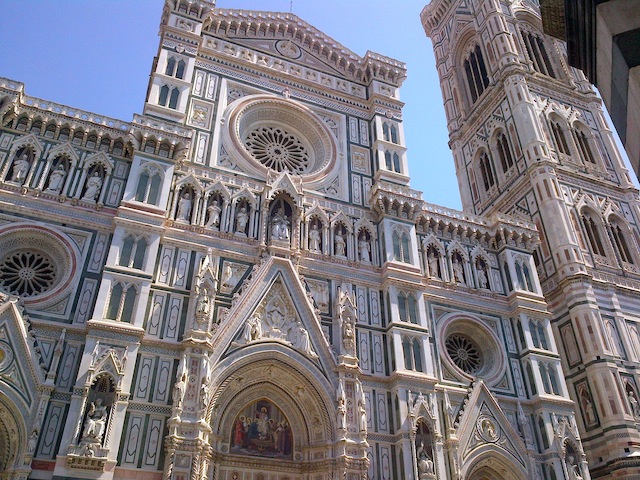
Don’t Miss the Duomo, the Florence Cathedral
The Duomo, also known as the Cattedrale Santa Maria del Fiore, or the Cathedral of Saint Mary of the Flowers, is a pastel vision of magnificence, and is an essential part of any one day in Florence itinerary.
The cathedral was planned back in 1296 and took centuries to complete. The showstopper is its massive dome, which was added in 1436.
A structural wonder, it was the largest dome that had ever been built, and was designed by Filippo Brunelleschi. Still today, the orangey-red herringbone brick of the dome is an unmistakable part of the Florence skyline.
It’s the exterior of the Duomo, however, that touches my soul, an ethereal confection of white marble from Carrera, pink marble from Maremma and green marble from Prato, along with intricate carvings and reliefs.
Inside isn’t as ornate. Other than the glowing dome, you could say it’s downright plain and simple. We have Savonarola and his ideas of austerity to thank for that.
If you look to your left you will, however, see a fresco by Paolo Uccello, the Equestrian Monument to Sir John Hawkwood, which was painted in 1436.
Like a moth to a light, however, you’ll probably be drawn immediately to the cupola of the dome. Crank your neck so you can see the enormous fresco of the Last Judgment by none other than Giorgio Vasari. Remember him? He was the architect of both the Uffizi and the Hall of the Five Hundred. Yes, he was an artist too.
Painting the cupola was a huge undertaking and Vasari died before it was completed, so Federico Zuccari took over.
From such a height the ceiling painting looks pastoral and heavenly, but the most famous bit is actually the gruesome devil-laden scenes of Hell, where naked bodies are being torn apart, flayed, attacked with pitchforks and carted off by horrible horned creatures.
It’s quite frightening, just very hard to see.
Buy Duomo Tickets Entrance to the Duomo is free, but the lineups can be as frightening as the scenes of Dante’s Ninth Circle of Hell. Save time with a Duomo Priority Entrance tour.
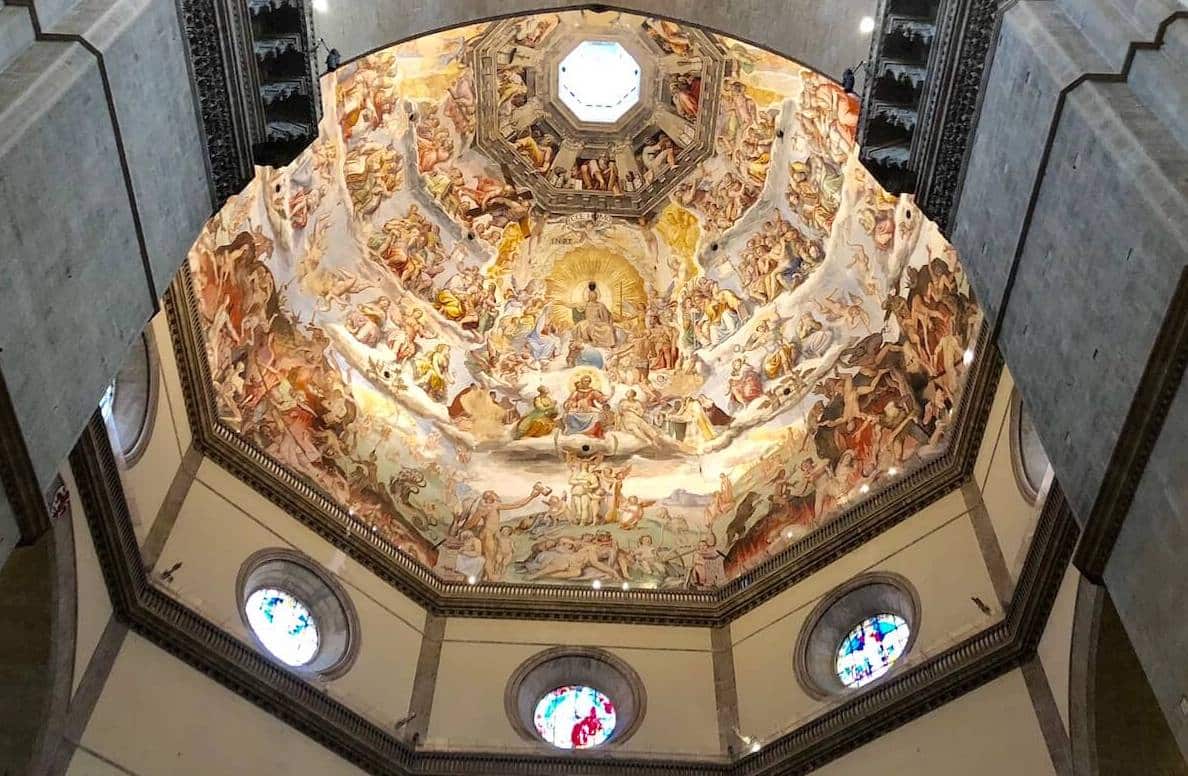
What to Do in Florence in a Day for Exercise – Climb the Dome
If you’re looking for active things to do in Florence, you can climb up the 463 steps to the cupola. Apparently it’s a must-do activity in Florence. At least that’s what they tell me. Next time I’m going to do it. For sure. It’s one way to get a closer look at the Last Judgement.
While it costs nothing to enter the cathedral, there is a charge to climb the dome. You can book a Duomo Priority Entrance Tour that includes the Brunelleschi’s Dome here.
Explore the Piazza del Duomo
Once you’ve left the Duomo, you’ll be back on the Piazza del Duomo and there are a few wonderful things to see here. It’s one of the top places to visit in Florence in 1 day as there is something to see wherever you turn.
Take a look at the Baptistry of San Giovanni, one of the oldest churches in Florence. Built between 1059 and 1128, it has a unique octagonal design.
Particularly famous are its bronze doors with their gleaming religious panels, so masterful that Michelangelo referred to the East Gates crafted by sculptor Lorenzo Ghiberti the ‘Gates of Paradise.’
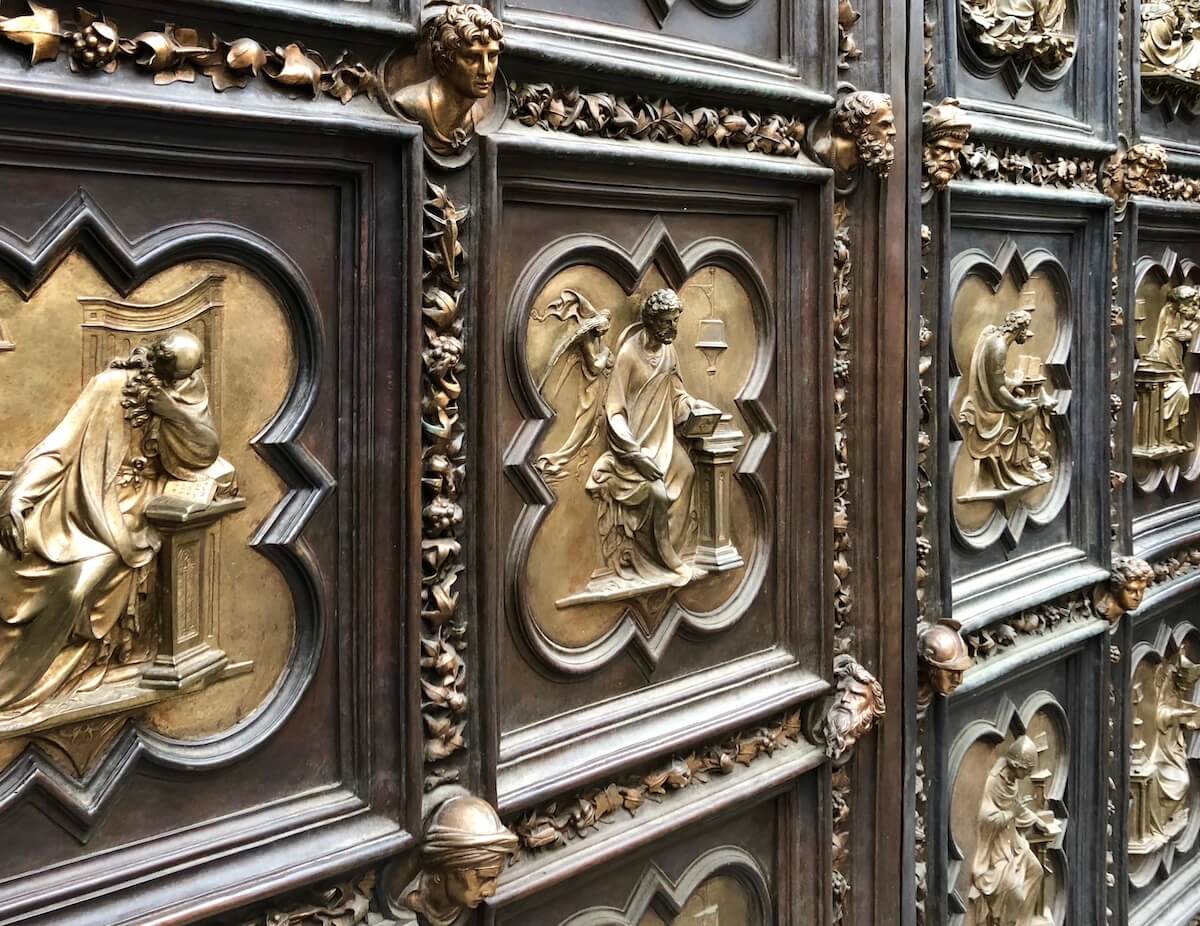
See Giotto’s Bell Tower
Another top Florence attraction on the Piazza del Duomo is Giotto’s Bell Tower, the Campanile di Giotto. It’s an exquisite example of Gothic architecture. It was started in 1334, and after Giotto’s death it was completed by Andrea Pisano.
If you still have any energy left over, you can climb its 414 steps.
2 Day Florence Itinerary
Still wondering what to do in Florence? If you have more than a day you can visit the Bargello Museum, the Basilica di Santa Croce, the Pitti Palace and the Boboli Gardens. If you have even more time you could go to the Piazzale Michelangelo for the view, though it’s a bit out of the way.
The Bargello Museum in Florence
The quiet and peaceful museum at Via del Proconsolo, 4, is home to another renowned statue of David, Donatello’s bronze. Older and smaller than Michelangelo’s David, it’s a strange sultry statue, the first free-standing nude to be sculpted after the Dark Ages. (Read more about these famous David statues of Italy.)
If you’re interested in Bernini statues, a highlight of visiting the Bargello Museum, at least for me, is the practically-breathing bust of Costanza Bonarelli, Bernini’s lover and nearly his downfall.
Even if you only have 24 hours in Florence, it’s a great museum to squeeze in, and not so big it’s overwhelming.
Basilica di Santa Croce
The Basilica de Santa Croce, built in the 13th century, is the resting place of many greats such as Michelangelo, Machiavelli and Galileo. There is also a monument to Dante here.
The basilica holds a number of art treasures such as Giotto’s frescoes showing the Life of Saint Francis and the Lives of Saint John the Evangelist and Saint John the Baptist, as well as a gilded relief of the Annunciation by Donatello.
The Pitti Palace
Built for the wealthy Pitti family in 1457, this ornate palace later became a Medici residence. Today it houses several galleries including the the Royal Apartments and the Gallery of Modern Art.
Book your ticket for the Pitti Palace here.
Boboli Gardens
Behind the Pitti Palace are the beautiful Italian gardens of the Medicis, an elegant green space filled with statues, grottos, fountains, flowers and centuries-old trees. It’s an ideal place to visit in Florence on a warm sunny day.
Get your Boboli Gardens entry ticket here.
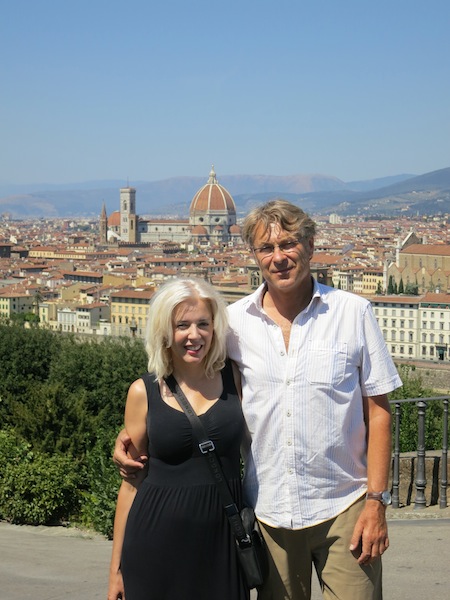
The Piazzale Michelangelo
It’s outside the center, but the Piazzale Michelangelo offers one of the best views of Florence. Bonus: You’ll see yet another replica David not quite by Michelangelo. What’s more authentic than that?
Florence Restaurants
After all that sightseeing you deserve a big meal. And, unless you’re a vegetarian, it’s only right to lust after a Beefsteak Florentine, a dish traditionally cooked on a wood-fired grill and made from local Chianina beef.
One to try is Ristorante da Lino on Via Santa Elisabetta 6r Tel: +39 055 284579.
Is Florence Worth It?
Of course. Was there any doubt? Hopefully this guide for planning a Florence day trip has given you a taste of Renaissance history and some great ideas of what to see.
From world-class art to breath-taking climbs (I mean, literally, breath taking), the wonderful city of Firenze, will take you back in time.
Florence Hotels
You may be in Florence on a day trip, but if you’re doing it in 24 hours, there are many hotel options. Here are a few ideas.
Luxury: The luscious Four Seasons Hotel Firenze is a former convent. But don’t expect austerity. The 2-star Michelin restaurant and 2-level spa bumps your trip into luxe territory. Luxury travel doesn’t get much better than this.
Outside the city: If the tourist crowds are getting to you, consider staying outside the city at a property such as Il Salviatino, a hotel set on the hillside of Fiesole with views of Florence and an appealing outdoor pool.
Central: Near the Uffizi is the 5-star Hotel Bernini Palace. The setting, in a 15th-century palace, is only a 5-minute walk from the romantic Ponte Vecchio.
Central: Even closer to the Ponte Vecchio is the top-rated Portrait Firenze, a sleek deluxe Lugarno Collection hotel with a setting on the Arno River.
Heated outdoor pool: With an outdoor pool, the opulent Villa Cora is 2 km from the historic centre of Florence and not far from the Boboli Gardens.
Affordable: Farther out, but easier on the budget, is the 4-star Starhotels Tuscany. The #2 Tram will take you into the historical centre.
Florence Day Trips
Florence is right on the train line and there are a lot of great towns that are easy to get to by both regional or high speed train.
Lucca is a fascinating walled city about 90 minutes away by train on the regional line.
The spa town of Montecatini is interesting for its spa history and elaborate thermal water drinking hall. It’s about an hour and 15 minutes from Florence by train. (It’s not a traditional bathing destination like some other Tuscan spas.)
Pistoia is a great walkable town about an hour by train from Florence that doesn’t see the crowds.
Can you see Rome from Florence on a day trip? Yes. By high speed train you can do it in less than an hour and a half.
You can even do Florence to Venice, though it takes longer at two and a quarter hours.
From Florence to the best Tuscan hot springs: Spas in Tuscany are fantastic places for Florence day trips, but you really need a car. Check out my Tuscany hot springs travel guide for more info.
Resources
Read more about Italy: about the Top Cities to Visit in Italy And don’t miss Unusual things to do in Rome.
Here’s a good read if you’re into gruesome history and gripping tales: The Birth of Venus: A Novel by Sarah Dunant.
For more of the best places in Europe to see: visit Top Destinations in Europe
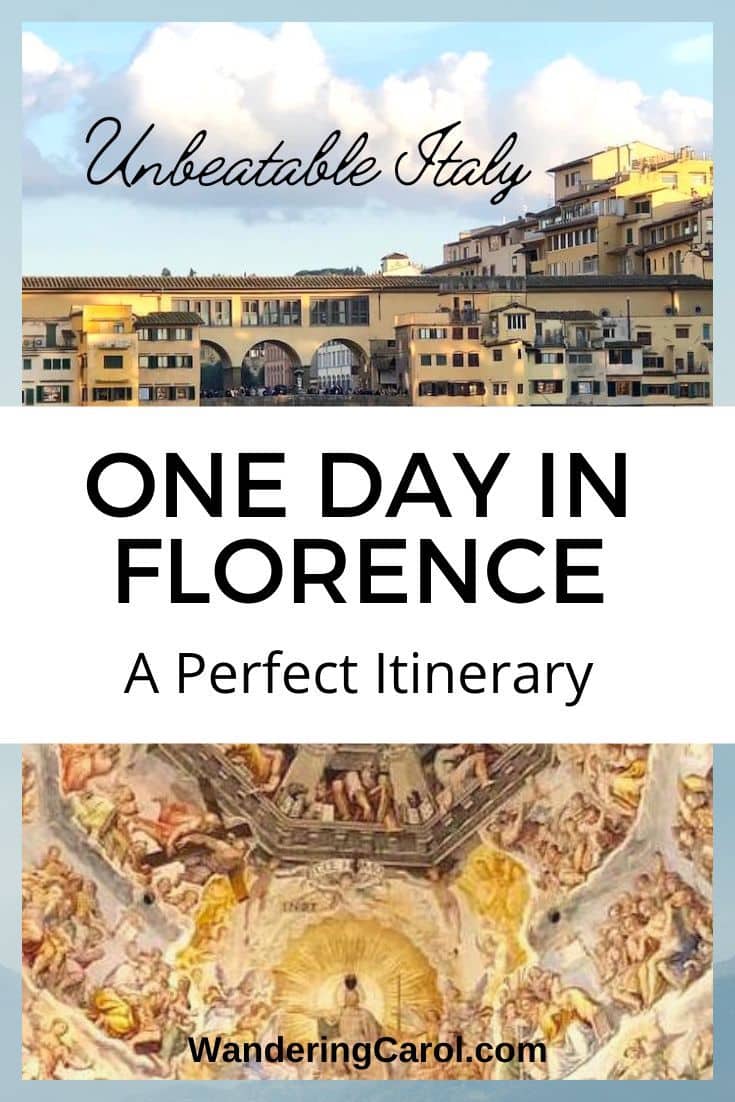
 20 Fun Things to Do in Banff, Canada
20 Fun Things to Do in Banff, Canada
Leave a Reply